Abstract
The growing importance of digital technologies in the context of digital transformation is a particularly promising, dynamic area of scientific research. This is especially true for the public sector, where the degree of response to complex government and public problems should be built in a rapid and flexible manner, causing the need to provide valuable digital services in real time. The aim of the study is to form a model of the digital technological architectural environment of public administration, which allows achieving such tasks as increasing transparency and satisfaction of citizens and businesses in providing public services. The article presents a structured approach to the digital transformation of public administration, which is a transition from the traditional to an integrated transformative system of digital government, consistent with the context and content of the federal project "Digital Public Administration", included in the national project "Digital Economy of the Russian Federation". This article describes the key processes that will determine the strategic contours of the digital transformation of public administration. The result of the study is to foresee the priority of Russia's technological development in modernizing public administration in the context of deep penetration of digital technologies that improve the provision of public services. The formed conclusions on the implementation of the results will contribute to scientific research aimed at implementing programs of structural changes in public administration.
Keywords: Digitalizationdigital economydigital technologiesmodernizationpublic administration
Introduction
Digital transformation has become a global trend, a common place of attention to the issues of digitalization of many world powers. The importance of the project of digital transformation of the public sector was announced by Presidential Decree No. 204 of May 7, 2018 "On national goals and strategic objectives of the development of the Russian Federation for the period up to 2024" (Decree of the President of the Russian Federation No. 204 of 07.05.2018 "On national goals and strategic objectives of the development of the Russian Federation for the period up to 2024"), within which it is necessary to develop information technologies, information systems and the possibility of using these technologies in various industries, from public administration to science, education, taking into account the requirements of information security, building a secure and properly balanced digital information infrastructure (Zavalko, 2019).
Modern global trends of digitalization form a new paradigm of development, which entails fundamental changes in the processes of implementing strategic modernization of public administration. This is mainly due to the increasing importance of technological and organizational innovations, the development of the network digital architecture of relations and other phenomena associated with the accelerating globalization of the world economy. The process of technological digital transformation is particularly relevant for public administration, where the degree of response to complex government and public problems must be built in an operational and flexible way. Digitalization is a new quality that can change how management decisions are made, how the state interacts with society, with entrepreneurs, but also, most importantly, how it can affect the efficiency of the state system work.
The analysis of the federal project showed (Decree of the President of the Russian Federation No. 204 of 07.05.2018 "On the national goals and strategic objectives of the development of the Russian Federation for the period up to 2024") that it highlighted the priorities in the field of digital transformation of public services, with relatively less attention paid to developing a structured architectural approach, the target parameters of the implementation of digitization from the point of view of their impact on improving the quality of implementation of state functions. This circumstance requires further study, which confirms the relevance of the study. The development of an architectural technological environment will provide the basis for effective digital public administration, contributing to the achievement of strategic objectives of the state. This goal can be achieved by coordinating the scientific and technological policy of the Ministry of Digital Development, Communications and Mass Communications of the Russian Federation with the scientific and technological forecasting system established in the country.
Digitalization of public administration involves technological changes, which requires the state administration to adapt accordingly in the provision of public services. Over the past decades, ICT and e-government have been acclaimed as the key to changes implementation (Alonso et al., 2016). However, it should be noted that there is currently some dissonance. On the one hand, we are now discussing and thinking about new technologies, on the other hand, the tools that are used in public administration are already outdated. Is it possible to achieve a digital future without these tools, taking into account the speed of technological change? How will we shape the digital future? Data is the new "fuel", it is what decision-making in public administration will be based on. First of all, we focus on the definition of digital transformation of public administration.
New opportunities for digital public service delivery related to data mining, machine learning, sensor technologies, and service automation have been discussed by both academics and politics (Lindgren et al., 2019). Digital transformation in the public sector means new ways of working with stakeholders, creating new frameworks for service delivery, and creating new forms of relationships (Mergel et al., 2019). In our opinion, the digital transformation of public administration is a qualitative transition from automation to digital management of processes and services, based on the use of new high-tech "breakthrough" tools that ensure the construction of a digital "smart government" using artificial intelligence and taking into account historical, statistical, and constantly changing data. Studies have shown that there are stages of digital transformation (Figure
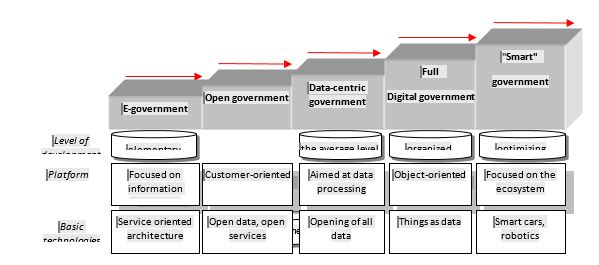
In our opinion, we are somewhere in the first or second stage, with some pretension of moving to the third stage, to a data-centric government. Speaking about the future, it becomes clear that technologies will develop and the state as a platform, this is a technology associated with the third, fourth and fifth stages of digitalization of public administration. The analysis of the stages of maturity of digital public administration shows the importance of changes not only in the ways of implementing state functions, but also in the technological processes and subprocesses performed in the implementation of state functions and public services. Digital service groups are thus one of the current ways in which governments are seeking to accelerate the transformation of e-service delivery to meet the changing needs of users (Mergel, 2019). In our opinion, the current stage of digitalization of public administration is characterized by some problems that digital technologies can help solve at the present stage. These problems are related, firstly, to the fact that each tool, as a rule, creates its own system and the disunity of these systems actually leads to the need for duplication of efforts. The second problem is related to the fact that in most cases, management uses data that was once entered manually by someone, so any manual input is a risk of certain distortion and errors. The third point that we would like to draw attention to is the weak integration of the system on the one hand and, on the other hand, their overregulation. Since each information system has a "master", it sets the functional load of a particular system and, unfortunately, these functions are not always enough for all users of the system. Another point is the fact that at the moment the analysis of the collected results is largely reduced to calculating the degree of achievement of indicators, fixing the fact of the occurrence of an event. That is, we know that something is done or not done, but what to do with it after this is not quite clear. In this sense, further development in the paradigm of already digital government, in our opinion, could help to overcome many of these problems.
Problem Statement
Governments have gradually begun to move away from traditional methods of administering digital platforms (Neklyudova & Antropov, 2020). In our opinion, the main criteria for the digital transformation of public administration is a change in the content of its architectural environment, which would lead to an increase in the quality of public administration, to its validity, efficiency. As a result, we will not just get automation or digitization of a particular process, but we will get a certain new quality for citizens, for business and for internal customers of the state itself. The digital transformation of public administration will increase the satisfaction of citizens in the provision of public services. The digital transformation of public administration is dominated by an approach based on technological determinism. When implementing changes, it is important to take into account technological capabilities, which are extremely important for the implementation of transformational processes.
Research Questions
The research questions for this article were: what does digitalization of public administration mean in the modern sense? Is it possible to achieve a digital future without modern digital tools, taking into account the speed of technological changes? What are the main stages of digital transformation of public administration? How is the digital environment of public administration formed? What are the features of the scenario for the development of the digital architecture of public administration? What is the content of the current state of digitalization of public administration? How will we shape the digital future of public administration?
Purpose of the Study
The aim of the study is to form a model of digital technological architectural environment of public administration, which allows to achieve such tasks as increasing transparency and satisfaction of citizens and businesses in the quality of public services providing. The authors have structured the definition of digital transformation of public administration, which is a transition from the traditional to the integrated transformative approach of digital government. We have formed prospects for using the opportunities of digitalization of public administration, including its digital transformation, for further mastering the principle of results-based management, and improving its effectiveness. The authors of the study developed a technological architectural environment for the digital future of public administration, aimed at building a single state digital platform based on a single digital profile - a digital twin. The developed structure will significantly improve the process of digital interaction with society, with business, but most importantly, improve the process of efficiency of the state system.
Research Methods
To solve research problems, the authors used a set of scientific methods. The theoretical and methodological basis was the basic provisions of the study of processes and phenomena: system analysis, abstraction, analysis and synthesis. The main method was the foresight methodology, which includes a wide range of research methods: scanning horizons, analyzing scenarios, and prospects for the digital technology market. This method allowed us to identify the most functional information resources necessary for the study.
The predictive approach used in the study differs from standard methods. The foresight methodology is based on long-term models for a comprehensive assessment of the development of the digital technology market in a scenario form and determining the outline of the digital future, including public administration. The use of foresight methodology makes it possible to more clearly define the main directions of digital transformation of the public sector. For the key processes that will define the technological architectural environment of digital public administration, appropriate resources were selected for further analysis, on the basis of which the following visualizations were made:
- predictive maps of the digital future of public administration;
- trends map.
This analysis was supplemented by a horizontal scan, which included a literature review, which was applied to identify technological trends in the digitalization of the public sector.
Findings
We will make conclusions that from a technical point of view is a solution that the authors suggest. The process is relevant in which it is necessary to ensure that business, companies, citizens and the state move to communication in a single digital environment.
As already noted in the stages of digital transformation, this is far from the case now, despite the considerable progress that has been made in the digitalization of public services. Now, first of all, the departmental model is being implemented. Taking into account current trends, this model is already outdated and a transition to a client-centered model is necessary (Figure
Each government agency is responsible at different levels for how it conducts digitalization and how it collects data.
Very often, these data are not related to each other. Now that we are in the era of virtual platform solutions, it is very important that the state, represented by all its levels of government, simultaneously with business and citizens, can move to these platform solutions and, accordingly, keep up with all other world powers.
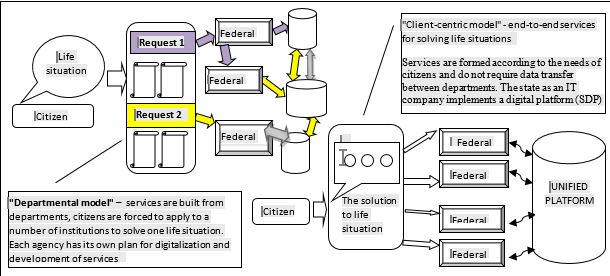
Speaking about the characteristics of the current situation on the digitalization of public administration, it should be noted that now there are about 250 thousand sites of both state bodies, municipalities, and separately the government, which are not structured. It is important that at some point all this comes into a single front system that would allow the citizen to quickly find what he needs. It is necessary to move away from the existing digital "feudalism", when all their systems are developed separately, they do not know how to communicate with each other and cannot communicate in order to switch to a single format for an array of data.
This does not mean that the information is stored in one place, it means that the data is comparable to each other and everyone understands where and how they can be found. Understanding not only in the literal sense, but "understanding" systems built on the basis of artificial intelligence. The algorithm knows where everything is, and how the data can be used, which can then be useful.
This circumstance is related to how to build a single metamodel of the data that is collected in the country. Now it is necessary to overcome this, including the approach proposed by the authors, that is, the state should act as a transferring IT corporation.
In many ways, this means that there should be directors for digital transformation in the authorities, that will be guided by the same architectural principles. It is very important that when moving to platform solutions, we get common architectural principles on which all this will be built. Accordingly, the authors propose a model of the information within the structure state, which takes into account current trends in the digital transformation of public administration (Figure
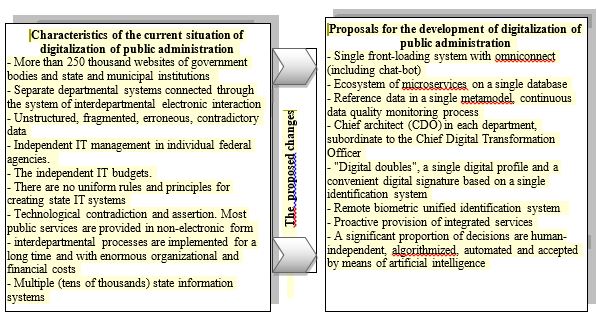
Thus, in our opinion, it is important to transfer all services into electronic form on the basis of a single digital platform.
New data-driven processes are based on the ability to quickly change these processes and implement interagency, inter-level coordination much faster. In our opinion, it is necessary to implement a proactive presentation of integrated services, that is, access to all services that are available in automatic mode, including not only public services, but also services for the development of companies' business.
Get to a process where a significant proportion of decisions that can be made in a control system in a digital environment are carried out automatically and human-independent.
It should be noted that within the framework of the digital economy program, the section public administration is adopted, but it does not yet have a clear understanding of how the digital architecture will be built. Now there is a risk of how this development will happen.
You can keep the development in the previous logic and gradually develop the system without losing what you have accumulated.
However, we can come to the conclusion that the same digital "feudalism" will remain in the transition to platform solutions. As a result, we will not get any effect. The scenario that, in our opinion, needs to be built is the construction of a single state digital platform, which would be based on a single digital profile, in fact a digital double, of both a person and organizations (Figure
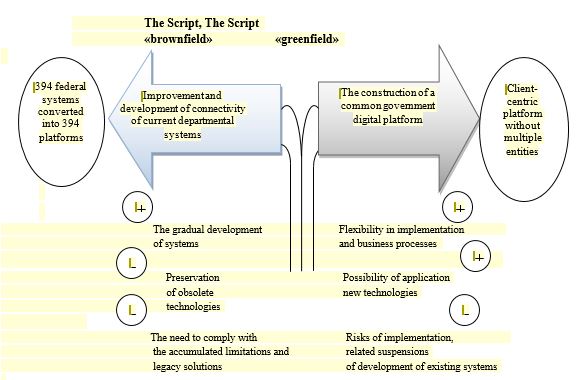
We will highlight the principles for the development of the state digital platform (Table
Of course, there are some elements of digitalization now. However, they are not implemented at the qualitative level to be truly elements of a single digital platform
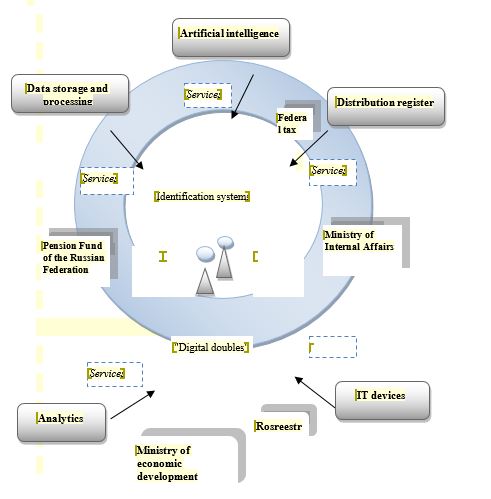
The transition of the state to digital technologies requires radical changes in all processes, where the state should start working as an advanced IT company. The availability of certain databases is determined by the availability or ability to support obtaining the array in electronic form (Tibilova et al., 2019). We will form the key architecture of the platform, which, in our opinion, is more effective for creating a digital unified environment for digital transformation of public administration (Figure
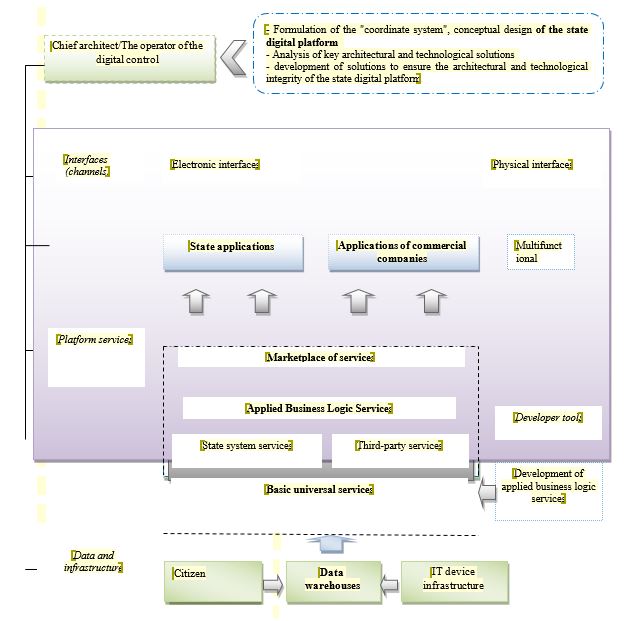
The presented digital architecture, the key things that need to be done - open IP and the possibility of non-machine interaction and cloud infrastructure. Now everyone is already integrated into this system. On the one hand, we need to develop our capacities so that they appear, on the other hand, we need to understand that these are huge infrastructure investments and we will have to use a lot of what we already have. It should be noted that satisfaction with public services was largely achieved through the creation of Multifunctional Public Services Center. But now time is already ahead of us, which means that it is impossible to maintain the same level by the same methods. We will have to move to a different infrastructure. In fact, this is the possibility of targeted support of proactive services. The main challenge facing the public administration system is architectural solutions, building up infrastructure and changing the organizational culture - the culture of working with data, the culture of information development.
Conclusion
Main findings of the study:
- digital transformation of public administration is a qualitative transition from automation to digital management of processes and services, based on the use of new high-tech "breakthrough" tools that ensure the construction of a digital "smart government" using artificial intelligence and take into account historical, statistical, constantly changing data;
- organizational efficiency of development in the digital government paradigm can be achieved by moving to the stage of data-centric and "smart government" based on the use of modern digital technology tools;
- it is necessary to move to a single format for an array of data built on the basis of artificial intelligence, that is, the state should act as a transmitting IT corporation and be guided by common architectural principles;
- it is necessary to implement a proactive presentation of integrated services, that is, access to all services that are available in automatic mode, including not only public services, but also services for the development of companies' business. Move to a process where a significant proportion of decisions that can be made in a digital management system are made in an automated and human-independent manner;
- the architectural environment of the state digital platform is a single software and hardware environment that supports algorithmized relationships between the state, citizens, and business. From a technical point of view, these are several layers: this includes the data infrastructure, basic and universal services, applied business logic, and the application layer;
- Table
The first limitation in implementing digitalization of public administration is due to the fact that there is a significant time lag between the achievement of results and their evaluation. The solution is to make more active use of big data and internet of things technology. The second limitation is the predominance of manual input, which can later distort the information. In the future, the Internet of things involves automatic correction and automatic acceptance of some management actions. This article laid the foundation for studying the architectural environment of digitalization of public services, presenting the contours of a single digital public administration. The definition of digital transformation of public administration was expanded by the author's definition, including the development of a scenario for its digital development. Future research may be related to the assessment of the implementation of state functions by reducing transaction costs and a comprehensive analysis of business cases in the implementation of new technologies.
Studies in the field of digitalization of public administration has done little to analyze user satisfaction in new forms of interaction. Therefore, additional studies may focus on how satisfied users are with the digitalization of public services. Studies that address this can contribute to an overall better understanding of the social dimension of big data and can provide rich theoretical and practical insights. Further research is needed to examine the elements of the digital architecture of public administration, approaches to digital transformation, as well as the results of digital service delivery activities as part of the implementation of digital transformation approaches in government. The results of this study highlight the opportunities for in-depth evaluation of digital transformation programs in public administration. Conclusions on the implementation of the foresight results will contribute to scientific research aimed at implementing programs of structural changes in public administration. Thus, the effectiveness of digitalization of public administration can be expressed in improving the system of public services, in the emergence of a variety of organizational, managerial and social effects.
References
- Alonso, J., Escalantea, M., & Orue-Echevarria, L. (2016). Transformational cloud government (TCG): Transforming public administrations with a cloud of public services. Procedia Computer Science, 97, 43-52.
- Decree of the President of the Russian Federation No. 204 of 07.05.2018 "On national goals and strategic objectives of the development of the Russian Federation for the period up to 2024". https://www.gov.spb.ru/gov/otrasl/c_information/informaciya-ob-ispolnenii-ukaza-prezidenta-rossijskoj-federacii-204-ot/
- Lindgren, I., Madsen, C. Ø., Hofmann, S., & Melin, U. (2019). Close encounters of the digital kind: A research agenda for the digitalization of public services. Government Information Quarterly, 36(3), 427-436.
- Mergel, I. (2019). Digital service teams in government. Government Information Quarterly, 36(4), 101389.
- Mergel, I., Edelmann, N., & Haug, N. (2019). Defining digital transformation: Results from expert interviews. Government Information Quarterly, 36(4), 101385
- Neklyudova, N. P., & Antropov, V. A. (2020). Digital technologies in employment of migrant workers. European Proceedings of Social and Behavioural Sciences, 90, 1126-1232.
- Tibilova, G. S., Ovcharenko, A. V., Stankova, E. N., & Dyachenko, N. V. (2019). The electronic government of St.-Petersburg as relevant experience of construction of digital economy. In S. Misra, O. Gervasi, B. Murgante, E. Stankova, V. Korkhov, C. Torre, A.M.A.C. Rocha, D. Taniar, B.O. Apduhan, E. Tarantino (Eds.), The Electronic Government of St.-Petersburg as Relevant Experience of Construction of Digital Economy (pp. 357-371). Springer.
- Zavalko, A. (2019). Current problems in the training of digital personnel for the cyber economy and how to solve them. In V. M. Filippov, A. A. Chursin, J. V. Ragulina, & E. G. Popkova (Eds.), The Cyber Economy. Contributions to Economics (pp. 135-142). Springer.
Copyright information

This work is licensed under a Creative Commons Attribution-NonCommercial-NoDerivatives 4.0 International License.
About this article
Publication Date
30 April 2021
Article Doi
eBook ISBN
978-1-80296-105-8
Publisher
European Publisher
Volume
106
Print ISBN (optional)
-
Edition Number
1st Edition
Pages
1-1875
Subjects
Socio-economic development, digital economy, management, public administration
Cite this article as:
Pudovkina, O. E., Ivanova, E. V., & Khazova, D. L. (2021). Modern Trends In The Formation Of Architectural Environment Of Public Administration Digitalization. In S. I. Ashmarina, V. V. Mantulenko, M. I. Inozemtsev, & E. L. Sidorenko (Eds.), Global Challenges and Prospects of The Modern Economic Development, vol 106. European Proceedings of Social and Behavioural Sciences (pp. 1119-1130). European Publisher. https://doi.org/10.15405/epsbs.2021.04.02.133

